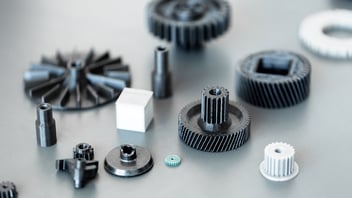5-axis CNC machining is an advanced manufacturing method that offers flexibility and precision in the machining of complex parts. This process uses a computer-controlled machining center capable of moving the tool or workpiece in five different directions simultaneously.
The primary advantage of 5-axis machining is the ability to create highly complex shapes and geometries in a single setup. This method offers significant benefits over more traditional 3-axis or 4-axis machines and is particularly well-suited for machining intricate and precision-demanding parts.
Operating principle of 5-axis machining
In traditional 3-axis CNC machining, the tool moves in three directions: X-axis (left-right), Y-axis (forward-backward), and Z-axis (up-down). In 5-axis machining, two additional rotational axes, known as the A and B axes, are utilized.
The A-axis rotates the workpiece around the X-axis, and the B-axis rotates it around the Y-axis. This allows the tool to be positioned at an optimal angle relative to the workpiece, improving efficiency and quality while reducing tool wear.
5-axis CNC machining differs from 3- and 4-axis machines, especially in terms of movement complexity, versatility, and the precision of the parts produced. While 3-axis machines are simple and suitable for traditional machining tasks, 4-axis machines offer more flexibility. In contrast, 5-axis machining provides complete freedom of movement, enabling the production of highly complex and precise parts in demanding machining tasks with a single setup.

Higher quality and shorter lead times with 5-axis machining
The advantages of 5-axis machining include improved accuracy and quality, shorter lead times, the ability to create complex geometric shapes, and better surface finishes.
The tool can be adjusted to an optimal position relative to the workpiece, allowing it to follow the surface more smoothly without unnecessary angles or interruptions in movement. This enhances the surface quality of the final product and reduces the need for post-processing steps, such as grinding or other finishing operations.
The tool can also be tilted and rotated to machine complex undercuts and curved surfaces that would be difficult or impossible to achieve with traditional 3- or 4-axis machines. A 5-axis machine can reach difficult-to-access areas and angles, which in traditional 3-axis machining would require reorienting and re-clamping the workpiece between operations.
Repositioning and re-clamping the workpiece is costly because it takes time and can increase the risk of errors and inaccuracies. A 5-axis machine can perform multiple operations in a single setup, such as drilling, milling, and turning. The versatility of the 5-axis machine reduces the need for new setups, which in turn shortens the machining time and improves both the efficiency of the process and the quality of the machined part.
>> Download the guide to assist in designing machined parts and save with smart design solutions!
Manufacturing complex shapes with 5-axis machining
The most significant advantage of 5-axis machining is the ability to produce highly complex shapes and geometries, often with a single setup. This is particularly important for intricate precision parts, such as components used by manufacturers in the defense industry and medical technology, as well as injection molds. Here are examples of parts that can be manufactured with a 5-axis machining center:
- Defense industry components
In the production of enclosures for electronic devices, such as radar and communication systems, 5-axis machining is used to create complex shapes and precise fittings. - Medical technology components
Medical imaging devices, such as housings for surgical camera systems, lenses, and sensors, can be highly complex in structure. - Semiconductor industry components
Parts of vacuum chambers and other enclosures in semiconductor devices, which have complex internal shapes, can be manufactured with 5-axis machining centers. - Molds
Mold manufacturing, for example, for injection molding, requires highly precise shapes that critically impact the quality of the final products. 5-axis machining enables the production of molds with deep cavities, curved surfaces, and precise details. - Prototype parts
In many industries, 5-axis machining is used for producing complex prototypes with unusual shapes and multiple parallel machining movements. The production of these prototypes often requires parts that cannot be easily manufactured by other methods.

Automation and robotics enhance 5-axis machining
Automation and robotics can significantly enhance 5-axis machining, improving production quality and flexibility. Cobots, or collaborative robots, can be used to feed workpieces. At Mectalent, cobots, for instance, load blanks into the CNC machine, increasing machine utilization and reducing production costs.
5-axis machines often include automated tool changers that switch tools according to the machining program. This not only reduces the time needed for tool changes but also enables uninterrupted operation, resulting in better work quality.
Machining is our core expertise
5-axis CNC machining opens new possibilities for design and manufacturing. It enables the implementation of innovative solutions and the efficient, precise production of even the most challenging parts. Therefore, 5-axis machining is an indispensable tool in the production of complex geometries and precise shapes.
At Mectalent, experienced precision machining professionals are at your service. We provide solutions for all your needs, whether it’s small prototype batches or larger continuous production runs.




